20 PHP CMS Open Source Content Management Systems
CMS is the abbreviation of Content Management System, which means "content management system". Content management system is the new favorite in enterprise information construction and e-government, and it is also a relatively new market. A content management system or CMS is an application used to manage news. Users can publish, edit and delete articles from the backend management system. HTML and other scripting languages are not required to operate the CMS, although using them adds further advantages.
Since we have looked at 22 open source PHP frameworks, I decided to review 20 open source PHP content management systems so that readers who do not have strong PHP knowledge can use free and open CMS Source code to easily create their website.
1. WordPress
WordPress is a powerful and easy-to-use content management system. Originally it was designed as a blogging platform. Then, it slowly gained popularity and could be customized into a powerful CMS with a few tricks and plugins. I wrote an article about SEO plugins and also talked about things you should know about WordPress 2.8.
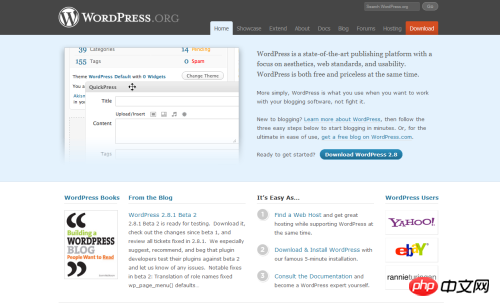
2. Drupal
Drupal is a free and open source modular framework and content management system (CMS) written in PHP. It is used as a backend system for many different types of websites, from small personal blogs to large corporate and political websites.
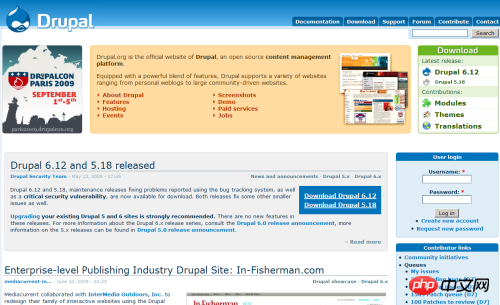
3. Joomla
Joomla is an award-winning content management system (CMS) that enables you to build websites and powerful online applications. Many aspects, including its ease of use and scalability, make Joomla the most popular software for websites. The best thing is that Joomla is an open source solution and is available to everyone for free.
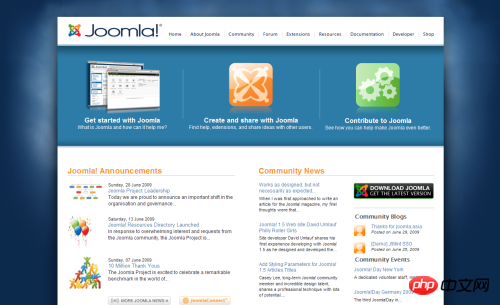
4. Frog CMS
Frog CMS simplifies content management and provides an elegant user interface, flexible page templates, simple user management and permissions and the tools necessary for file management.
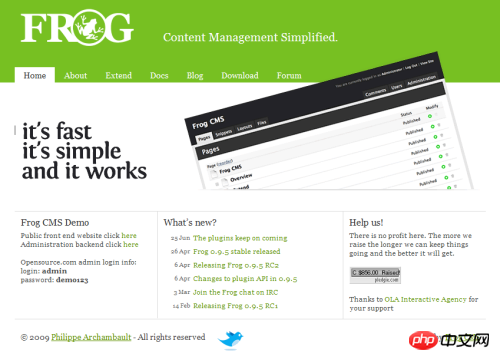
5. SilverStripe
SilverStripe is a PHP CMS built with the Sapphire framework, using the MVC design pattern. You can view a sample website for building SilverStrip e from the official webpage.
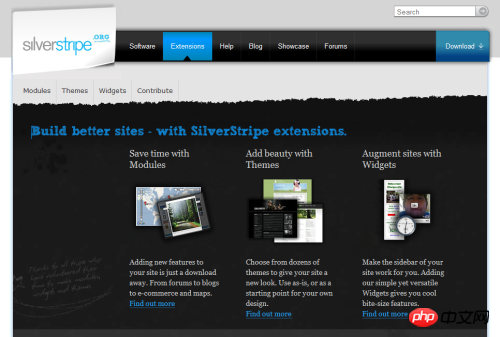
6. Mambo
Mambo is a full-featured, award-winning software that can be used for everything from simple web pages to complex enterprise applications management system. While some Mambo websites have moved to Joomla, I thought I would include Mambo as it is still a great CMS.
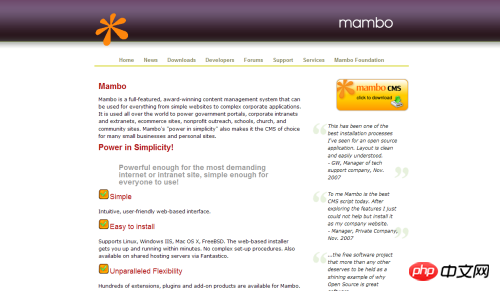
7. TYPOlight
TYPOlight is a PHP 5 CMS, which has many features, such as real-time updates, cross-browser CSS framework generation Machine-based (IE7 compatible), template-based front-end output using Ajax and Web 2 technologies. You should check the homepage for more information.
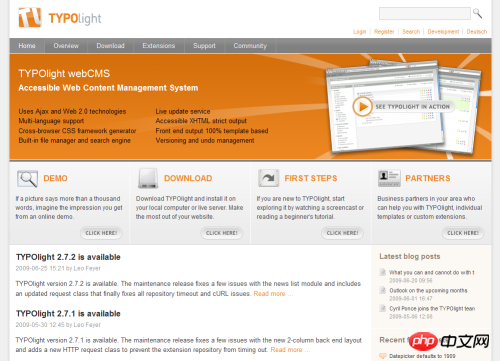
8. Concrete5
Concrete5 is an open source content management system with a simple administrator interface. Web pages can be edited using the editing toolbar provided after the administrator logs in.
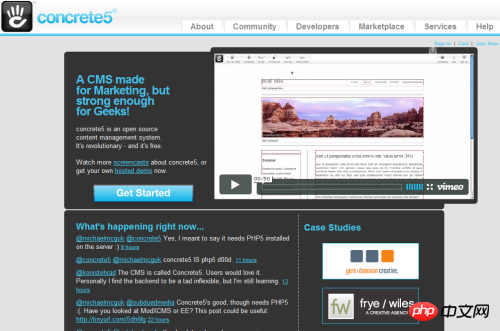
9. Textpattern
Textpattern is another very popular content management system. It requires PHP 4 to run a variety of custom plugins that you can use.
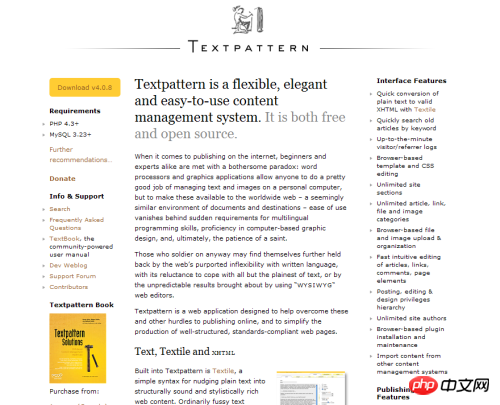
10. Symphony
Symphony is a CMS that uses XML/XSLT as the template language. Symphony lets you customize anything you like, from your website’s URL structure to your publishing environment. For non-programmers, this CMS can be complex.
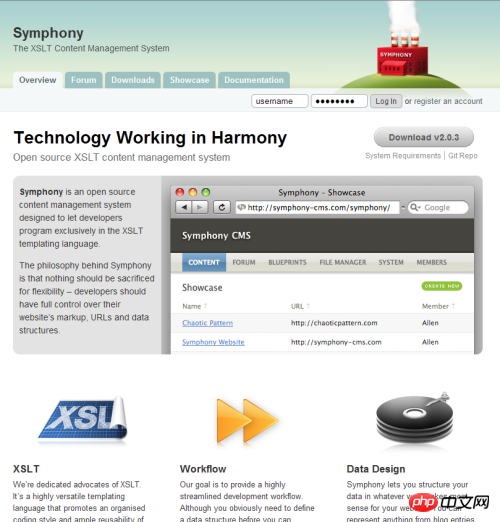
11. MODx
MODx is an open source PHP application framework that can help users control their own online content. It is an ideal control system for developers and power users. Anyone can use MODx to publish, update, and maintain dynamic websites, or website content for static html pages.
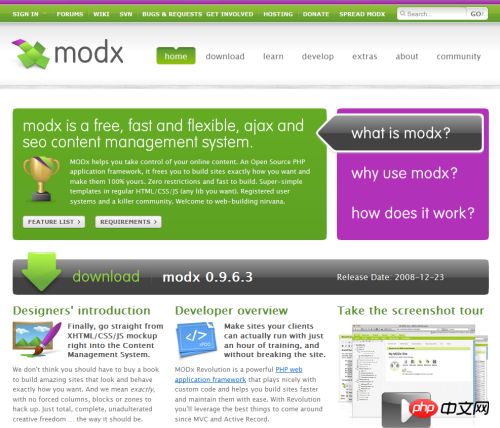
12. Habari Project
Habari is an open source blog system specially written for modern web development environments, using current object-oriented programming technology.
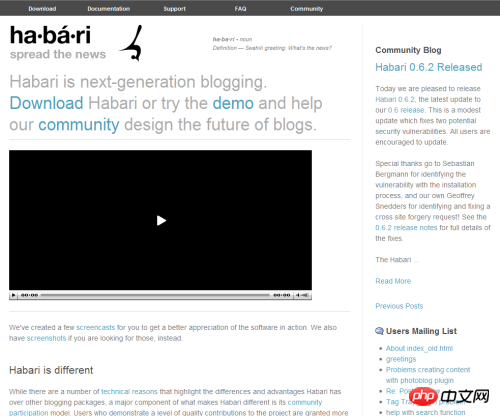
13. CMS Made Simple
CMS Made Simple is an easy-to-use content management system that provides a variety of templates for download. Its documentation is complete and easy to view.
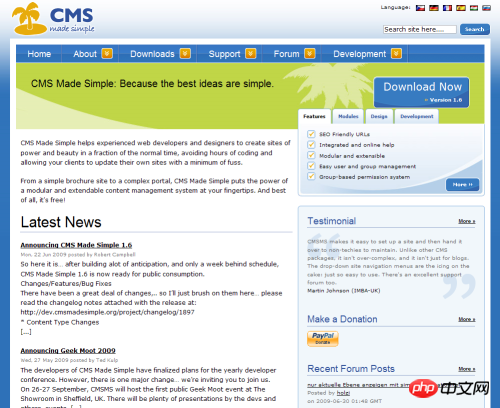
14. ImpressCMS
ImpressCMS is a database (MySQL) driven, modular content management system that is highly scalable and very useful for managing communities.
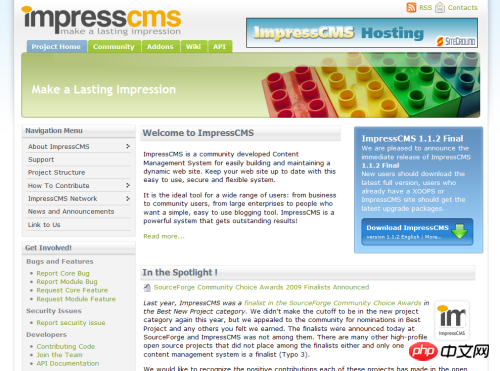
15. Exponent CMS
Exponent uses an intuitive and flexible content editing system that allows website pages to be displayed on the page. You can download templates and themes from the official website!
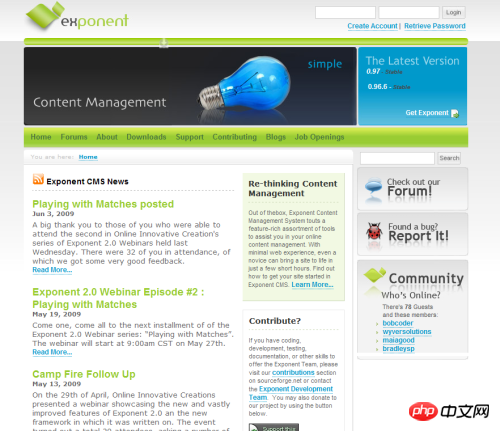
16. MiaCMS
MiaCMS is a fork of Mambo CMS. It has a powerful and scalable third-party registration system, as well as flexible site theme capabilities. MiaCMS supports OpenID and is expected to develop into a stable and mature CMS.
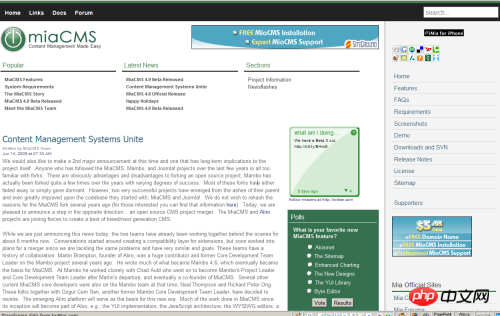
17. Jojo CMS
Jojo is a search engine friendly CMS. In addition to providing SEO-friendly URLs in articles, Jojo can also solve www/non-www issues. Jojo can also extend functionality by adding databases, blogs, image galleries, and anything else you like.
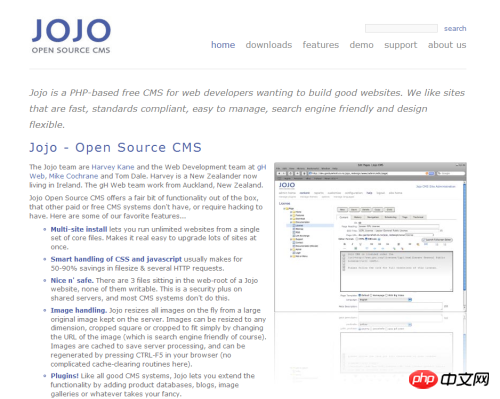
18. TYPO3
TYPO3 is an open source content management system (CMS) and content management framework (CMF). It offers complete flexibility and scalability with mature, ready-made interfaces, functions and modules.

The above content is 20 PHP CMS open source content management system sharing, I hope it can help everyone.
Related recommendations:
ThinkPHP5 Practical Combat [Teaching Management System] Full Record
Graduation Project Purchase, Sales and Inventory Management System --From Basic construction begins
Today’s recommendation: ten simple and elegant website backend management system templates
The above is the detailed content of 20 PHP CMS Open Source Content Management Systems. For more information, please follow other related articles on the PHP Chinese website!

Hot AI Tools

Undresser.AI Undress
AI-powered app for creating realistic nude photos

AI Clothes Remover
Online AI tool for removing clothes from photos.

Undress AI Tool
Undress images for free

Clothoff.io
AI clothes remover

Video Face Swap
Swap faces in any video effortlessly with our completely free AI face swap tool!

Hot Article

Hot Tools

Notepad++7.3.1
Easy-to-use and free code editor

SublimeText3 Chinese version
Chinese version, very easy to use

Zend Studio 13.0.1
Powerful PHP integrated development environment

Dreamweaver CS6
Visual web development tools

SublimeText3 Mac version
God-level code editing software (SublimeText3)

Hot Topics
 1664
1664
 14
14
 1423
1423
 52
52
 1317
1317
 25
25
 1268
1268
 29
29
 1246
1246
 24
24
 Explain JSON Web Tokens (JWT) and their use case in PHP APIs.
Apr 05, 2025 am 12:04 AM
Explain JSON Web Tokens (JWT) and their use case in PHP APIs.
Apr 05, 2025 am 12:04 AM
JWT is an open standard based on JSON, used to securely transmit information between parties, mainly for identity authentication and information exchange. 1. JWT consists of three parts: Header, Payload and Signature. 2. The working principle of JWT includes three steps: generating JWT, verifying JWT and parsing Payload. 3. When using JWT for authentication in PHP, JWT can be generated and verified, and user role and permission information can be included in advanced usage. 4. Common errors include signature verification failure, token expiration, and payload oversized. Debugging skills include using debugging tools and logging. 5. Performance optimization and best practices include using appropriate signature algorithms, setting validity periods reasonably,
 PHP Program to Count Vowels in a String
Feb 07, 2025 pm 12:12 PM
PHP Program to Count Vowels in a String
Feb 07, 2025 pm 12:12 PM
A string is a sequence of characters, including letters, numbers, and symbols. This tutorial will learn how to calculate the number of vowels in a given string in PHP using different methods. The vowels in English are a, e, i, o, u, and they can be uppercase or lowercase. What is a vowel? Vowels are alphabetic characters that represent a specific pronunciation. There are five vowels in English, including uppercase and lowercase: a, e, i, o, u Example 1 Input: String = "Tutorialspoint" Output: 6 explain The vowels in the string "Tutorialspoint" are u, o, i, a, o, i. There are 6 yuan in total
 Explain late static binding in PHP (static::).
Apr 03, 2025 am 12:04 AM
Explain late static binding in PHP (static::).
Apr 03, 2025 am 12:04 AM
Static binding (static::) implements late static binding (LSB) in PHP, allowing calling classes to be referenced in static contexts rather than defining classes. 1) The parsing process is performed at runtime, 2) Look up the call class in the inheritance relationship, 3) It may bring performance overhead.
 What are PHP magic methods (__construct, __destruct, __call, __get, __set, etc.) and provide use cases?
Apr 03, 2025 am 12:03 AM
What are PHP magic methods (__construct, __destruct, __call, __get, __set, etc.) and provide use cases?
Apr 03, 2025 am 12:03 AM
What are the magic methods of PHP? PHP's magic methods include: 1.\_\_construct, used to initialize objects; 2.\_\_destruct, used to clean up resources; 3.\_\_call, handle non-existent method calls; 4.\_\_get, implement dynamic attribute access; 5.\_\_set, implement dynamic attribute settings. These methods are automatically called in certain situations, improving code flexibility and efficiency.
 PHP and Python: Comparing Two Popular Programming Languages
Apr 14, 2025 am 12:13 AM
PHP and Python: Comparing Two Popular Programming Languages
Apr 14, 2025 am 12:13 AM
PHP and Python each have their own advantages, and choose according to project requirements. 1.PHP is suitable for web development, especially for rapid development and maintenance of websites. 2. Python is suitable for data science, machine learning and artificial intelligence, with concise syntax and suitable for beginners.
 PHP in Action: Real-World Examples and Applications
Apr 14, 2025 am 12:19 AM
PHP in Action: Real-World Examples and Applications
Apr 14, 2025 am 12:19 AM
PHP is widely used in e-commerce, content management systems and API development. 1) E-commerce: used for shopping cart function and payment processing. 2) Content management system: used for dynamic content generation and user management. 3) API development: used for RESTful API development and API security. Through performance optimization and best practices, the efficiency and maintainability of PHP applications are improved.
 PHP: A Key Language for Web Development
Apr 13, 2025 am 12:08 AM
PHP: A Key Language for Web Development
Apr 13, 2025 am 12:08 AM
PHP is a scripting language widely used on the server side, especially suitable for web development. 1.PHP can embed HTML, process HTTP requests and responses, and supports a variety of databases. 2.PHP is used to generate dynamic web content, process form data, access databases, etc., with strong community support and open source resources. 3. PHP is an interpreted language, and the execution process includes lexical analysis, grammatical analysis, compilation and execution. 4.PHP can be combined with MySQL for advanced applications such as user registration systems. 5. When debugging PHP, you can use functions such as error_reporting() and var_dump(). 6. Optimize PHP code to use caching mechanisms, optimize database queries and use built-in functions. 7
 The Enduring Relevance of PHP: Is It Still Alive?
Apr 14, 2025 am 12:12 AM
The Enduring Relevance of PHP: Is It Still Alive?
Apr 14, 2025 am 12:12 AM
PHP is still dynamic and still occupies an important position in the field of modern programming. 1) PHP's simplicity and powerful community support make it widely used in web development; 2) Its flexibility and stability make it outstanding in handling web forms, database operations and file processing; 3) PHP is constantly evolving and optimizing, suitable for beginners and experienced developers.




